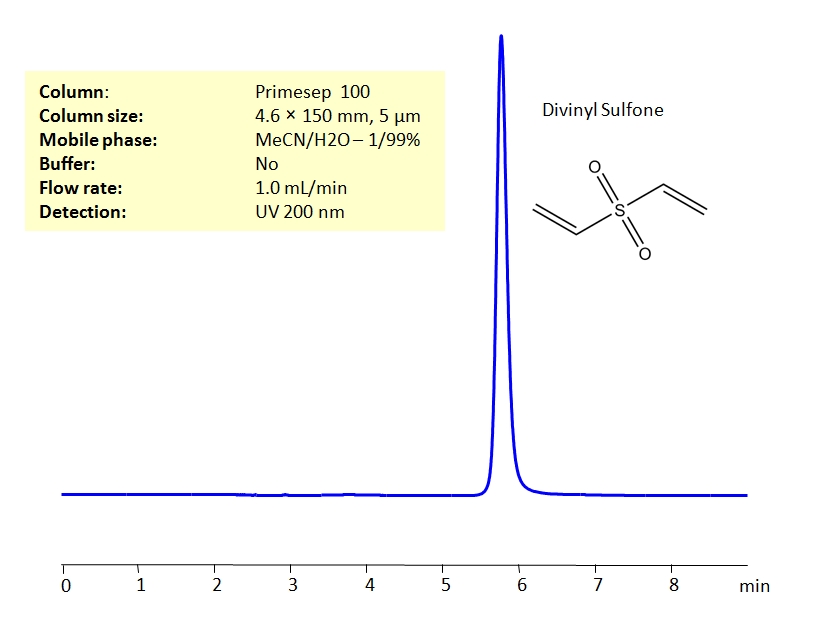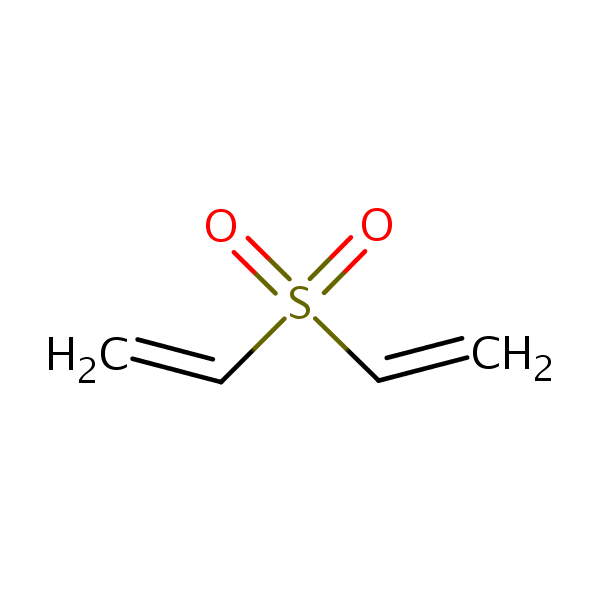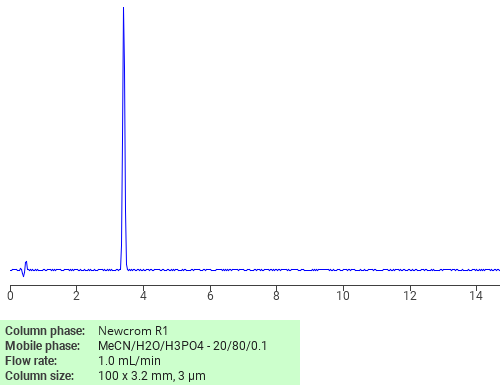| CAS Number | 77-77-0 |
|---|---|
| Molecular Formula | C4H6O2S |
| Molecular Weight | 118.151 |
| InChI Key | AFOSIXZFDONLBT-UHFFFAOYSA-N |
| LogP | 0.294 |
| Synonyms |
|
Applications:
UV-Vis Spectrum of Divinyl Sulfone
July 22, 2024
Access the UV-Vis Spectrum SIELC Library
UV-Vis Spectrum of Divinyl Sulfone. Absorption Maxima: 200 nm.
If you are looking for optimized HPLC method to analyze Divinyl sulfone check our HPLC Applications library
For optimal results in HPLC analysis, it is recommended to measure absorbance at a wavelength that matches the absorption maximum of the compound(s) being analyzed. The UV spectrum shown can assist in selecting an appropriate wavelength for your analysis. Please note that certain mobile phases and buffers may block wavelengths below 230 nm, rendering absorbance measurement at these wavelengths ineffective. If detection below 230 nm is required, it is recommended to use acetonitrile and water as low UV-transparent mobile phases, with phosphoric acid and its salts, sulfuric acid, and TFA as buffers.
For some compounds, the UV-Vis Spectrum is affected by the pH of the mobile phase. The spectra presented here are measured with an acidic mobile phase that has a pH of 3 or lower.

HPLC Determination of Divinyl Sulfone on Primesep 100 Column
March 17, 2021
HPLC Method for Analysis of Divinyl sulfone on Primesep 100 by SIELC Technologies

High Performance Liquid Chromatography (HPLC) Method for Analysis of Divinyl Sulfone
Divinyl sulfone (C4H6O2S) is an organic compound with a vinyl group (-CH=CH2) attached to a sulfone group (-SO2-). It’s a colorless liquid that is used in organic synthesis and polymer chemistry due to its ability to act as a crosslinker.
Applications:
- In bioconjugation chemistry, it’s used for modifying proteins or attaching drugs to carriers.
- It’s used to prepare hydrogels for biomedical applications, such as drug delivery systems and tissue engineering scaffolds.
- It can be used in the synthesis of various polymers with specific properties.
In practical use, divinyl sulfone’s reactivity needs to be carefully controlled, as its ability to crosslink can lead to the formation of highly crosslinked, insoluble polymers if not properly managed.
Divinyl sulfone acts as a cross-linking reagent for agarose gels. It is a monomer used in the production of polymers with diols, urea and malonic esters.
Divinyl sulfone can be retained on a Primesep 100 mixed-mode column with great peak shape using an isocratic method of 1/99 Acetonitrile (ACN) and water. UV Detection 200 nm.
Condition
| Column | Primesep 100, 4.6 x 150 mm, 5 µm, 100 A, dual ended |
| Mobile Phase | MeCN – 1.0% |
| Buffer | No |
| Flow Rate | 1.0 ml/min |
| Detection | 200 nm |
| Peak Retention Time | 5.8 min |
| LOD* | 50 ppb |
| Sample (Divinyl Sulfone (stabilized with HQ)) | 0.2 mg/ml in H2O |
| Injection volume | 1 µl |
*LOD was determined for this combination of instrument, method, and analyte, and it can vary from one laboratory to another even when the same general type of analysis is being performed
Description
| Class of Compounds | Vinyl Monomer, Sulfone |
| Analyzing Compounds | Divinyl sulfone |
Application Column
Primesep 100
Column Diameter: 4.6 mm
Column Length: 150 mm
Particle Size: 5 µm
Pore Size: 100 A
Column options: dual ended

Separation of Divinyl sulfone on Newcrom R1 HPLC column
February 16, 2018
Divinyl sulfone can be analyzed by this reverse phase (RP) HPLC method with simple conditions. The mobile phase contains an acetonitrile (MeCN), water, and phosphoric acid. For Mass-Spec (MS) compatible applications the phosphoric acid needs to be replaced with formic acid. Smaller 3 µm particles columns available for fast UPLC applications. This liquid chromatography method is scalable and can be used for isolation impurities in preparative separation. It also suitable for pharmacokinetics.
Application Column
Newcrom R1
The Newcrom columns are a family of reverse-phase-based columns. Newcrom A, AH, B, and BH are all mixed-mode columns with either positive or negative ion-pairing groups attached to either short (25 Å) or long (100 Å) ligand chains. Newcrom R1 is a special reverse-phase column with low silanol activity.
Select options



